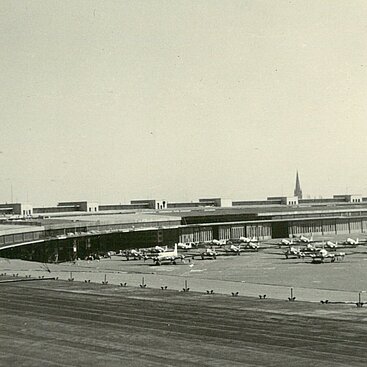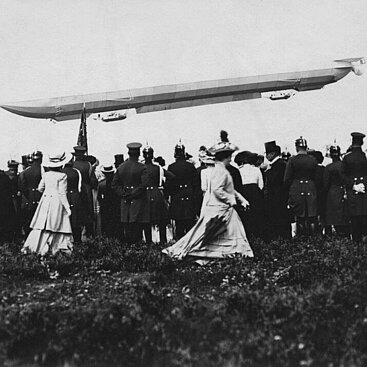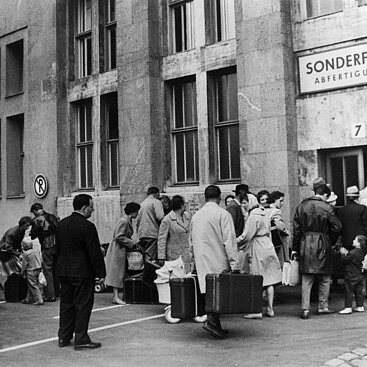KZ Columbia House
In 1933, in the first year of their command, the Nazis built a Gestapo prison at the northern edge of the Tempelhof field on the ground of what would later become the airport extension and then built a concentration camp in the following year. This was the only official concentration camp of SS in Berlin - a fact that is largely unknown.
Military prison
An empty prison building called “Columbia House” was used. It was built in 1896 as the third Berlin military prison. It was part of the barracks built at the same time on the other northern side of the current Columbiadamm, then called Prinz-August-von-Württemberg-Straße, and comprised a prison building with a guardroom and 156 cells, a courthouse and a civil servants' house. Soldiers who were barracked in the southern part of Berlin were punished here for disobedience. In 1918, the prison became “Tempelhof field prison”. It was subject to court inspection I, later the penal system office of Berlin. It got the name Columbia House in the honour of the aircraft “Columbia”, which landed on the Tempelhof field in 1927 after crossing the Atlantic. In 1929, the Prinz-August-von-Württembergstraße was also renamed to Columbiastraße; today it is called Columbiadamm.
Gestapo prison 1933 / 1934
The prison was closed at the end of 1920s and reopened in 1933. Owing to the wave of arrests of the early NS regime against political enemies, the existing detention sites quickly became overcrowded. Hence, another dark run-down house similar to Columbia House was restored, which had no longer complied with the sanitary and hygienic requirements during Weimar Republic. The first captives were most likely admitted in summer. An early prisoner report appeared in 1935 in the “Neuen Weltbühne” (New World Stage) published in Prague exile. It was written by Kurt Hiller, a Jewish author, pacifist and socialist. In July 1933, Hiller was brought here in the Prinz-Albrecht-Straße from Gestapo Central as a “prisoner 231” and he remained, as he wrote, “in this bloody hell for almost three and a half months”.
The prison in Columbia House was under the control of Gestapo, the Secret State Police employed to track political enemies in April 1933, and was monitored by SS men. SS, as the “Schutzstaffel” of NSDAP was called, became known for its unconditional commitment to Hitler. Columbia House quickly filled with prisoners, which had no place left in the house prison in Prinz-Albrecht-Straße 8, or were relocated from Spandau prison to intensified imprisonment. As the occupancy level reached 450 prisoners in February 1934, the space in the 156 individual cells became very confined. The prisoners were humiliated, abused, tortured and terrorised and many were killed. Just like the other locations of NS Terror, the Columbia House was a place with utter lawlessness and became infamous especially for brutal abuse. Gestapo and SS men practised terror that was so severe that in September 1934 “harassment” and “cruelty” were officially banned - a exceptional event for a concentration camp.
In the first few months of NS command, more than a hundred camps and torture chambers were established for the interrogation and abuse of political enemies in Berlin alone and “protective custody departments” were set up in prison sections. The “Reichstag Fire Decree” dated 28 February 1933 had unlimited “protective custody” and legalised arbitrary detention in concentration camps. Most of these camps were dissolved again after a few days, weeks or months. On the contrary, the Columbia House existed until November 1936, first as Gestapo prison, then as a part of the then emerging extensive concentration camp system.
Concentration camp Columbia 1934 – 1936
In December 1934, the Columbia House was put under the control of the newly established “Inspection of Concentration Camps”. It officially received the name “Columbia Concentration Camps”. Theodor Eicke, commander of Dachau Concentration Camp and “Inspector of Concentration Camps” from the summer of 1934 and the SS Totenkopfverbände (SS Death's Head Units), issued the camp rules, which were assigned to all the still existing and newly founded concentration camps in the Reich territory from the summer of 1934. The running of the concentration camp was believed to be an orderly imprisonment with a complex system of punishments, standards and regulations. In reality, the prisoners were unconditionally at the mercy of the commanders and despotism of the guards.
As the earlier part of this new centralised organisational form, KZ Columbia became the only SS-official independent concentration camp in Berlin urban area. It continued its special function as a detention site for the prisoners interrogated in the house prison of Gestapo Central; the prisoners were transported to and fro between KZ Columbia and Prinz-Albrecht-Straße thrice a day. At least 8000 men were prisoned in Columbia House - primarily all the political undesirables, communists, social democrats, intellectuals, democrats from different professions. Jewish prisoners were particularly tortured. In 1935, after the intensified raids in connection with “Röhm affairs“ and harsher punishment from paragraph 175 of the penal code (“severe sexual offence between men”), many homosexuals were brought in the Columbia House; at times, they made up half the number of prisoners.
The prisoners included many prominent people of the public life of Weimar Republic, for example, social democrats Ernst Heilmann, Theodor Haubach and Franz Neumann, communists Erich Honecker, Georg Benjamin and Werner Seelenbinder, Robert M. W. Kempner, later chief prosecutor of USA during the Nürnberg processes, advocate and defence lawyer Hans Litten, rabbi and president of Reich Deputation of German Jews Leo Baeck and cabaret artist Werner Finck. The prison conditions were cruel, hygienic conditions, food and medical care pitiful.
The SS commanders of Columbia House could prove their worth here in the sense of SS and position other “KZ careers”. These included Karl Otto Koch, who later became the commander of concentration camps in Sachsenhausen, Buchenwald and Lublin-Majdanek. His “duty album” contained a large number of photos, which showed the daily routine and the prisoners of KZ Columbia from the perspective of the offenders. The SS guard force was also trained here for subsequent KZ tasks.
In November 1936, KZ Columbia was dissolved and the prisoners were brought to the newly built KZ Sachsenhausen in Oranienburg, the “sample camp” of German capital. Its plans were drawn up in KZ Columbia and the buildings were constructed by the prisoners of the Columbia and Esterwegen camps. It is believed that KZ prisoners were no longer imprisoned in ramshackle buildings according to the ideas of Reichsführer SS Heinrich Himmler. They were rather imprisoned in “modern” expandable urban camp complexes. Moreover, Columbia House was in the way of the construction of Tempelhof airport “world airport”. In the spring or summer of 1938, the prison was torn down. How many deaths occurred in the Gestapo prison and KZ Columbia is not known. The offenders were not charged. The monument of the sculptor Georg Seibert at Columbiadamm, corner of Golßener Straße, is a reminder of the detention site and its victims since 1994.
St. Endlich, M. Geyler-von Bernus, B. Rossié
Anthology
Kurt Schilde, Johannes Tuchel, Columbia House. Berlin concentration camps 1933-1936, Berlin 1990 Johannes Tuchel, The concentration camp of Columbia. In: Günter Morsch (editor), From Sachsenburg to Sachsenhausen.





